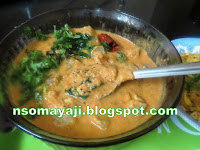Snake gourd is called Padavala in Kannada and tirulu means the inner tender part of Padavala. ( The seed also should be tender). This chutney is a side dish and goes well with Rice, Chapatis and Idlis.
Things Needed:
 Padavala kai Tirulu: 1 cup.
Padavala kai Tirulu: 1 cup.
Urd daal : 1 Table spoon.
Red Chilly : 5 to 6
Fresh Grated coconut: 4 to 5 Table spoons.
Ingh : a pinch
Salt: as required.
Tamarind pulp : 1 Table spoon.
Turmeric Powder: a pinch.
Curry leaves : 4 to 5
Coriander seeds : 1/2 Tea spoon.
Oil.: 1 Tea spoon.
Method:
Remove the soft part inside Padavalakai( Snake gourd) and keep it aside. ( Remember the seed should not be ripe or hard, Remove the seeds if it is hard or ripe). Cook this with tamarind pulp, salt and coriander seeds. Leave it for cooling. Now grate or cut fresh coconut and keep it aside. Keep a pan on the fire. Heat and put oil. Put urs daal and fry. Add red chillies and fry until urd daal is brown.( on the low flame). Then add curry leaves and ingh to it. Put off the gas and add coconut and mix well. Leave this for cooling. Now add the cooked Padavala pulp and roasted mixture of daal and coconut and grind with required salt till paste adding required water little by little. Remove from the Mixi jar and put it to the serving bowl. Serve this Padavala chutney with hot rice and a spoonful of ghee on the top of hot rice. Serving a piece of raw onion along with chutney with rice.
 Note : One must not use the ripe padavala seeds along with its pulp. ( soft inner part of snake gourd). Fry daal on lower heat. Can also add spurt mustard to this chutney will definitely give a better taste.
Note : One must not use the ripe padavala seeds along with its pulp. ( soft inner part of snake gourd). Fry daal on lower heat. Can also add spurt mustard to this chutney will definitely give a better taste.
Serves 2 to 3
Things Needed:
Urd daal : 1 Table spoon.
Red Chilly : 5 to 6
Fresh Grated coconut: 4 to 5 Table spoons.
Ingh : a pinch
Salt: as required.
Tamarind pulp : 1 Table spoon.
Turmeric Powder: a pinch.
Curry leaves : 4 to 5
Coriander seeds : 1/2 Tea spoon.
Oil.: 1 Tea spoon.
Method:
Remove the soft part inside Padavalakai( Snake gourd) and keep it aside. ( Remember the seed should not be ripe or hard, Remove the seeds if it is hard or ripe). Cook this with tamarind pulp, salt and coriander seeds. Leave it for cooling. Now grate or cut fresh coconut and keep it aside. Keep a pan on the fire. Heat and put oil. Put urs daal and fry. Add red chillies and fry until urd daal is brown.( on the low flame). Then add curry leaves and ingh to it. Put off the gas and add coconut and mix well. Leave this for cooling. Now add the cooked Padavala pulp and roasted mixture of daal and coconut and grind with required salt till paste adding required water little by little. Remove from the Mixi jar and put it to the serving bowl. Serve this Padavala chutney with hot rice and a spoonful of ghee on the top of hot rice. Serving a piece of raw onion along with chutney with rice.
Serves 2 to 3















